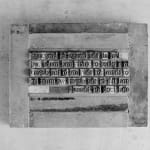Bouchra Khalili Morocco, b. 1975
The Typographer, 2019
16mm film, silent.
3’ 30’’
Edition 3 of 5 + 2 AP
While Jean Gent was known to the world as a poet and a writer, the only profession he was offered as an orphan gifted schoolchild was typography for which he...
While Jean Gent was known to the world as a poet and a writer, the only profession he was offered as an orphan gifted schoolchild was typography for which he received training for a short period of time, before fleeing from the workshop run by the public welfare system. In France, typography was traditionally the proffesion left to the gifted children of workers. Although his training in typography lasted for only weeks, Genet always paid great attention to the typesetting of his books, cultivating a fascination for typography as a metaphor of literary practice.
The Typographer depicts the typesetting and the printing of the last sentence Jean Gent wrote during his life-time. Following Genet's last will, that sentence forms the epigraph of Prisoners of Love, providing in retrospect an illumination of Genet's poetic art.Shot in 16 mm and in black and white, the use of celluloid fim operates here as a matephor of cinema as a technic of typesetting for images, emphasizing the nomadic power of words and images to navigate throughout minds, time, and media.
The Typographer depicts the typesetting and the printing of the last sentence Jean Gent wrote during his life-time. Following Genet's last will, that sentence forms the epigraph of Prisoners of Love, providing in retrospect an illumination of Genet's poetic art.Shot in 16 mm and in black and white, the use of celluloid fim operates here as a matephor of cinema as a technic of typesetting for images, emphasizing the nomadic power of words and images to navigate throughout minds, time, and media.




